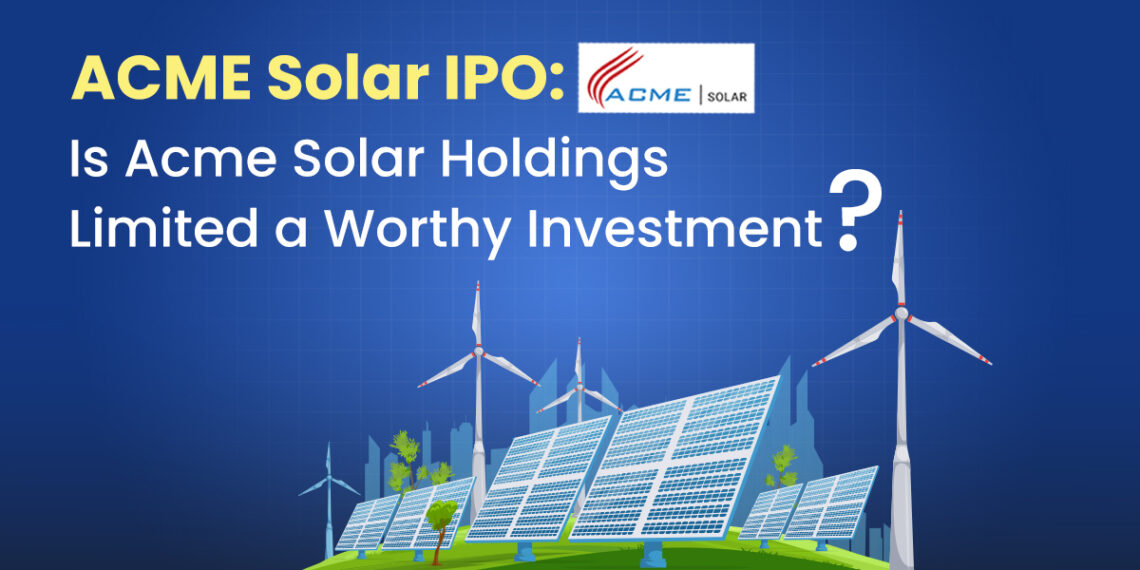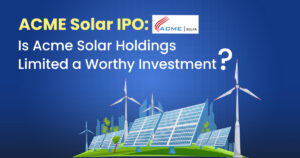Table of Contents
The renewable energy sector in India is glowing with opportunity, and ACME Solar Holdings Limited, a leading independent power producer, is making waves with its initial public offering (IPO).
Scheduled between November 6 and November 8, 2024, this IPO seeks to raise approximately ₹2,900 crores, presenting potential investors with a chance to own a slice of India’s renewable future. But is ACME Solar IPO the right addition to your investment portfolio?
In this blog, we’ll break down ACME Solar IPO’s objective, financial health, operational metrics, market positioning, and key risks.
ACME Solar IPO Details:
- IPO Open Date 06th November 2024, Wednesday
- IPO Close Date 08th November 2024, Friday
- Price Band ₹275 to ₹289 per share
- Lot Size 51 shares
- Face Value ₹10 per share
- Issue Size at upper price band ₹2900 crore (Fresh Issue ₹2395 crore and Offer For Sale ₹505 crore)
- Listing exchanges NSE, BSE
- Cut-off time for UPI mandate confirmation by 5 PM on November 08, 2024
The tentative timeline for the IPO is as follows:
- Basis of Allotment 11th November 2024, Monday
- Initiation of Refunds (if not allotted) 12th November 2024, Tuesday
- Credit of Shares to Demat (if gets allotments of shares) 12th October 2024, Tuesday
- Listing Date 13th October 2024, Wednesday
About the Company
ACME Solar Holdings Limited, established in 2015, is a renewable energy company with a portfolio of solar, wind, hybrid and firm & dispatchable renewable energy (FDRE) projects. With 1,340 MW of operational solar power capacity, 3,250 MW under construction, and 1,730 MW awarded, ACME Solar demonstrates significant growth potential. Its project locations span across 11 Indian states, reflecting an expansive footprint.
The company’s long-term power purchase agreements (PPAs) with government-backed entities like SECI (Solar Energy Corporation of India) and state distribution companies provide a steady revenue stream, making ACME Solar an attractive candidate in an industry where consistent cash flows are often challenging.
Renewable Energy Sector Outlook
India’s renewable energy capacity has been growing rapidly, thanks to supportive government policies and increased demand for clean energy. The total installed generation capacity as of March 2024 was ~442 GW, of which ~98 GW of capacity was added over FY18-FY24. The overall installed generation capacity has grown at a CAGR of 4.3% over the same period. About 9 GW of capacity has been added during FY25 as of August 2024. The installed capacity has now reached 451 GW as of August 2024.
By August 2024, renewable installations reached around 200 GW, making up 44% of India’s total energy capacity. The Indian government has committed to generating 40% of electricity from non-fossil fuel sources by 2030. The country also has a target of setting up 450 GW of renewable energy by 2030 and providing 17 lakh solar pumps to farmers under the Pradhan Mantri-Kusum Yojana.
Financial Performance
In recent years, ACME Solar’s revenue has fluctuated, with FY24 revenue from operations standing at ₹1,319 crores. Net profit, however, surged from a loss of ₹3 crores in FY23 to a profit of ₹698 crores in FY24, showcasing remarkable growth. The EBITDA margin stands at an impressive 82.6%, reflecting operational efficiency, while the debt-to-equity ratio at 4.87x as of June 2024 is a crucial aspect for investors to consider, given the capital-intensive nature of the business.
Now, let’s look at the key fundamental parameters of ACME Solar IPO and how it compares with its peer companies, Adani Green Energy Ltd. and KPI Green Energy Ltd., in this competitive landscape.
ACME Solar operates in a highly competitive market, facing rivals like Adani Green Energy and KPI Green Energy Limited. Despite being a relatively more minor player compared to Adani Green, which has a market cap of ₹2,60,146 crores, ACME Solar boasts one of the highest EBITDA margins at 82.6%, a competitive advantage reflecting operational efficiencies.
However, the competition is fierce, with rivals pushing for market share. For instance, Adani Green’s diversified portfolio includes 16.8 GW of solar capacity under construction, whereas ACME Solar’s pipeline stands at a more modest 6.3 GW.
Now look at the object of ACME Solar IPO.
Objectives of the Issue
ACME Solar IPO aims to raise ₹₹11,327 crore from this initial offer, out of which the fresh issue of ₹4,499 crore. The company proposes to utilize the Net Proceeds from Fresh issue towards funding the following objects:
- Investment in its subsidiaries for repayment/prepayment, in part, of certain outstanding borrowings availed by its subsidiaries.
- General corporate purposes.
There are no risk-free investments in the market. Let’s look at the risk considerations for ACME Solar IPO.
Risks and Challenges
Here are the risks that are highlighted for ACME Solar IPO
- Geographic and Revenue Concentration: A large portion of ACME Solar’s operational projects is concentrated in Andhra Pradesh, Rajasthan, and Telangana, which contributed 63% of the revenue in FY24. This concentration poses a risk if any policy changes or delays affect these regions.
- Dependence on Major Off-Takers: Approximately 90% of ACME Solar’s revenue comes from its top 10 clients, which exposes the company to high customer concentration risks.
- High Debt: ACME Solar’s high debt-to-equity ratio of 4.87x indicates significant leverage. While the IPO proceeds will reduce some debt, the capital-intensive nature of the business means the company may need additional financing for future projects.
- Component Sourcing and Cost Control: ACME Solar relies heavily on imports, especially from China, for solar panels and other equipment. This dependence makes the company vulnerable to supply chain disruptions, import restrictions, and currency fluctuations.
- Low Supplier Diversification: Around 79% of the total equipment purchases are from ACME Cleantech Solutions, which includes solar PV modules. This limited supplier base could potentially impact ACME Solar if any disruptions occur.
Should you subscribe to ACME Solar IPO?
The valuation at a post-issue market cap of ₹17,487 crores with a price-to-sales ratio of 13.3x at the upper price band suggests a premium. Comparatively, KPIs for industry peers such as Tata Power Renewable Energy and JSW Neo also indicate strong valuations, though ACME’s high EBITDA margin could provide justification for its premium.
Investors should weigh the high growth potential against the risks, especially with respect to ACME’s leverage and geographic concentration. For those with a high-risk tolerance and a long-term investment horizon, ACME Solar could represent a promising addition to a portfolio focused on renewable energy and infrastructure growth.
ACME Solar’s IPO brings a solid proposition to India’s rapidly growing renewable energy sector. With strong government backing, high EBITDA margins, and long-term revenue visibility, the company presents an attractive growth story. However, potential investors should remain cautious of the high debt levels and project concentration risks.
Before you decide to invest, it’s crucial to have a strong understanding of the potential risks and rewards involved. In this blog, we’ve presented a detailed overview of both the benefits and possible drawbacks associated with participating in the ACME Solar IPO. Our team of experts at StockEdge has assessed the ACME Solar IPO and provided a Good rating. Additionally, we’ve compiled a comprehensive IPO Note that dives deep into the company’s financial standing and SWOT analysis, offering thorough analysis to provide you with a more profound insight into the company’s prospects.
You can read our blog’s top renewable stocks in India, where you get more insights about renewable stocks.
StockEdge has a different section on IPO under the Explore tab, where you can see the list of upcoming IPOs, ongoing and recently listed IPOs.
Join StockEdge Club, where our team of research analysts will be dedicated to solving your query related to investments, trading or IPOs.
Happy investing!









